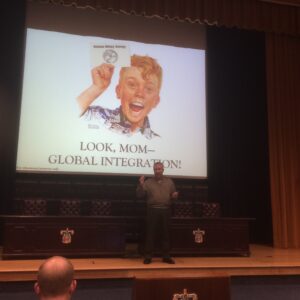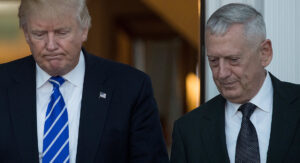
The military’s geographical Combatant Commands (COCOMs).
ARMY WAR COLLEGE: Global conflicts require global military decisions so the Joint Staff must step up to coordinate operations around the world, said a top aide to the Chairman of the Joint Chiefs. But, Marine Lt. Gen. Kenneth McKenzie told faculty and officer-students at the Army War College here, the Joint Staff can manage this role without new legal authorities and without undermining the authority of the nine Combatant Commands. In the end, the Chairman’s role will remain that of making recommendations to the Defense Secretary and the President, and it is these two — collectively the National Command Authority — who will make the decisions that cut across combatant commanders’ boundaries.
Gen. Joe Dunford, the current chairman, first floated this idea almost two years ago. “I personally don’t believe the current planning and organizational construct or command and control are optimized for the current fight,” Dunford said in September last year, adding a bit of meat to the bones. “What really is required is global integration.”

Lt. Gen. Kenneth McKenzie, J-5, addresses the Army War College.
“Since the Second World War” — with its clear division between European and Pacific theaters — “our approach has been regional,” said McKenzie, director for strategic plans and policy (J5) on the Joint Staff. “We need to change that. (Today), everything we do has global impact so…you have to move away from regional thinking.”
“It doesn’t mean the Joint Staff’s going to become a general staff,” McKenzie emphasized. “We actually actively argued against that in a recent congressional debate over the (National Defense Authorization Act),” where Senate Armed Services chairman John McCain suggested giving the Chairman of the Joint Chiefs limited authority to order forces from theater to theater. “We don’t need any more authorities for the Chairman,” who will remain outside the chain of command as an advisor to the Secretary of Defense.
To start with, more authority isn’t politically possible, McKenzie said. During studies last year, “we examined an idea that would give more authority to the Joint Staff. That is not an idea that has any viability in the American political system, within American culture,” he said. “The American people don’t want a general staff. They’ve been very clear on that since the end of the Second World War.”
Nor is additional authority necessary, McKenzie continued. “We believe, actually, that everything we need to do is available to us within current legislation,” he said. In the past, it’s not that the Joint Staff lacked authority, it’s that it didn’t use it to the fullest.
Conversely, “we don’t think that there’ll be any erosion or loss of combatant commander authority,” he said. “You’ve had some powerful personalities standing up here in the combatant commands. Nothing lessens their authorities.”
In fact, you want those regional perspectives to stay powerful. “You can’t homogenize the approach (where) everything’s decided in Washington,” he said. “You can’t template a single approach to everywhere, because there are uniquely different challenges depending where you are in the world, you’ve got to be keenly sensitive to that.”

Gen. Joe Dunford, Chairman of the Joint Chiefs of Staff
The Global Integrator
What, then, will the Joint Staff add?
Consider a war with Russia. You can’t reduce such a sprawling problem to a classic numbered war plan, McKenzie said. You still need to work out all the detailed logistical planning and sequencing of those traditional plans (known in Pentagonese as Time Phased Force Deployment Data, TPFDD). But no one combatant command could contain a conflict with Russia, which could spread beyond Europe (EUCOM) to
- the Pacific (PACOM),
- Afghanistan (CENTCOM),
- the Arctic (EUCOM and NORTHCOM),
- and to outer space and cyberspace (both under STRATCOM for now, but CYBERCOM will probably soon be independent).
- Reinforcement and resupply for any operation will have to flow by air and sea despite attacks by everything from hackers to submarines. That’s the task of Transportation Command, “probably the most stressed and vulnerable of the combatant commands.”
“You’ve got to tie all those activities together. You cannot do that at the regional combatant commander level,” McKenzie said. “I’ve been a combatant commander’s J-5, I know whereof I speak.”
That is where the Secretary of Defense comes in. He has authority to arbitrate and coordinate between the COCOMs, McKenzie said — but the Joint Staff does his legwork. “Whereas the regional combatant commander thinks about setting his theater for operations, we set the globe for the Secretary of Defense and the President to make their decisions,” said McKenzie.
“The global integrator is the chairman, (but) the chairman’s not in the chain of command,” McKenzie emphasized. “The chain of command for the application of force… is always going to go from civilian leadership to the combatant commanders.”

President Trump and Defense Secretary Jim Mattis
“We see absolutely no reason why the Joint Staff would ever get into that mix,” McKenzie continued, “but…we can assist the Secretary of Defense in making those decisions that he and the President will have to make that are uniquely theirs.”
What does all this mean in practice as combatant commands wrestle for limited resources? “Over time if the approach is going to mean anything… it’s going to drive allocation of resources,” McKenzie said. “You don’t get that overnight, because you don’t change posture overnight. But I would tell you over the next couple of years, as we adopt a top-down approach to this problem, we’re going to look at how forces are postured forward, how they rotate forward, what’s kept back, how the joint force measures its readiness.”
“I don’t think it’s going to change anything at the flying squadron, the infantry battalion, the ship level. We’ve very good there,” McKenzie said. “It’s a cultural change at the strategic level, where we actually think about how we link problems together.”
Don’t expect a wholesale redrawing of org charts or COCOM boundaries, because those popular shortcuts to reform rarely work, McKenzie said. “The organizational change is going to be very minimal because organizational change is usually unsatisfying,” he said. “You’ve got to drive the cultural change, talk to audiences like this.”
“We believe that war is changing,” McKenzie said. “We have an opportunity to change with it and perhaps anticipate it.”
China’s new H-20 stealth bomber ‘not really’ a concern for Pentagon, says intel official
“The thing with the H-20 is when you actually look at the system design, it’s probably nowhere near as good as US LO [low observable] platforms, particularly more advanced ones that we have coming down,” said a DoD intelligence official.


























